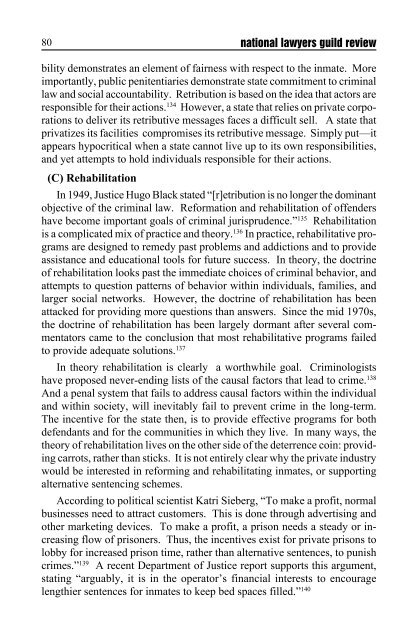Does your library have National Lawyers Guild Review?
Does your library have National Lawyers Guild Review?
Does your library have National Lawyers Guild Review?
You also want an ePaper? Increase the reach of your titles
YUMPU automatically turns print PDFs into web optimized ePapers that Google loves.
80 national lawyers guild reviewbility demonstrates an element of fairness with respect to the inmate. Moreimportantly, public penitentiaries demonstrate state commitment to criminallaw and social accountability. Retribution is based on the idea that actors areresponsible for their actions. 134 However, a state that relies on private corporationsto deliver its retributive messages faces a difficult sell. A state thatprivatizes its facilities compromises its retributive message. Simply put—itappears hypocritical when a state cannot live up to its own responsibilities,and yet attempts to hold individuals responsible for their actions.(C) RehabilitationIn 1949, Justice Hugo Black stated “[r]etribution is no longer the dominantobjective of the criminal law. Reformation and rehabilitation of offenders<strong>have</strong> become important goals of criminal jurisprudence.” 135 Rehabilitationis a complicated mix of practice and theory. 136 In practice, rehabilitative programsare designed to remedy past problems and addictions and to provideassistance and educational tools for future success. In theory, the doctrineof rehabilitation looks past the immediate choices of criminal behavior, andattempts to question patterns of behavior within individuals, families, andlarger social networks. However, the doctrine of rehabilitation has beenattacked for providing more questions than answers. Since the mid 1970s,the doctrine of rehabilitation has been largely dormant after several commentatorscame to the conclusion that most rehabilitative programs failedto provide adequate solutions. 137In theory rehabilitation is clearly a worthwhile goal. Criminologists<strong>have</strong> proposed never-ending lists of the causal factors that lead to crime. 138And a penal system that fails to address causal factors within the individualand within society, will inevitably fail to prevent crime in the long-term.The incentive for the state then, is to provide effective programs for bothdefendants and for the communities in which they live. In many ways, thetheory of rehabilitation lives on the other side of the deterrence coin: providingcarrots, rather than sticks. It is not entirely clear why the private industrywould be interested in reforming and rehabilitating inmates, or supportingalternative sentencing schemes.According to political scientist Katri Sieberg, “To make a profit, normalbusinesses need to attract customers. This is done through advertising andother marketing devices. To make a profit, a prison needs a steady or increasingflow of prisoners. Thus, the incentives exist for private prisons tolobby for increased prison time, rather than alternative sentences, to punishcrimes.” 139 A recent Department of Justice report supports this argument,stating “arguably, it is in the operator’s financial interests to encouragelengthier sentences for inmates to keep bed spaces filled.” 140












![NLGRev 68-2[1].indd - National Lawyers Guild](https://img.yumpu.com/30820772/1/167x260/nlgrev-68-21indd-national-lawyers-guild.jpg?quality=85)



